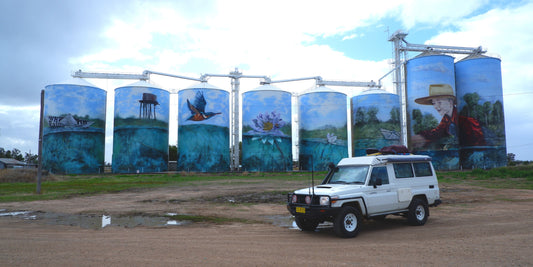Four-wheel driving requires specific techniques and car prep to tackle challenging terrains. This guide will provide some sweet insights and tips for navigating different terrain types safely and efficiently.
Gaining experience in different terrain will ramp up your confidence and skills. Don't forget to check the condition of a track before heading off on your adventure. As Lachie say's "Preparation prevents piss-pore performance".
Clearance
Some tracks require high clearance due to obstacles like creek crossings, rocks or ridges. High clearance is the distance between the car's lowest point (excluding tires) and the ground. Low-to-the-ground vehicles can get damaged or stuck when traversing uneven terrain. You wouldn't take a hatchback on an off-road dirt track. Ensure your car has sufficient clearance for the tracks you plan to explore.
Sand Driving
Driving on compacted sand can be smooth and enjoyable, but remaining cautious of hidden creek washouts is a good idea. The key to successful sand driving is adjusting tire pressure. Lowering the tire pressure increases its surface area and helps it float on the sand. Start by dropping the tire pressure to around 20 psi and adjust as needed. Carry a compressor to reinflate the tires when transitioning back to hard surfaces.
Water Crossings
Crossing water can be thrilling but also comes with hidden dangers. Walk through the water first to assess its depth and if there are any submerged trees, sharp rocks or quicksand. You want to make sure water won't get into your engine bay. I'd be wary of attempting a water crossing if you don't have a snorkel. Water crossings require careful and often quick decision-making to ensure a successful crossing.
Washaways
After heavy rain, unsealed roads can develop washaways and gullies, posing a car risk. Pay attention to the road and remain alert to avoid washaways. Even weeks after rain, these hazards can persist. Check the weather for the week before your trip to see any potential washaways in the area, and keep an eye on the rainfall during your trip.
Gravel Roads
Four-wheel and all-wheel drive cars handle gravel roads better than 2WD vehicles, but caution is still necessary. The high centre of gravity in 4WD vehicles makes them susceptible to rollovers if driven recklessly. Gravel road conditions change rapidly, especially after rain, transforming into slippery mud. Drive carefully and adapt to changing surface conditions.
Mud Driving
In areas prone to heavy rainfall, tracks can quickly become mud pits. Great for a mud wrestling match, not so much for road tripping adventures. Local rangers may close roads to prevent track damage. However, unexpected downpours can catch you off guard. Mud significantly reduces traction, making driving challenging. Consider using special mud tires and exercise caution when maneuvering through the mud. Getting bogged in the mud is a tough challenge to get out of.
Corrugations
Corrugations are ridges that form on roads due to heavy traffic. Find the optimum speed (around 60-70 km/h) to drive over corrugations comfortably. The vehicle skims over the ridges at this speed, providing a smoother ride. Driving too slowly or too fast can result in chattering teeth as you move across the corrugations or compromise car handling.
Rocky Tracks
Navigating rocky tracks demands slow and careful driving, mainly uphill or downhill. Rocks vary in shape and can puncture tires when flung up by the front wheels. Drive slowly to minimise the risk of tire damage and suspension problems. Watch out for sharp rocks puncturing a tire wall.
Mountain Driving
Unpredictable weather, including snowstorms and blizzards, can occur at any time. Always carry appropriate clothing and equipment for all conditions. Remember that short distances can become time-consuming due to adverse weather conditions. If a track is subject to seasonal closure, ensure you have a capable 4WD. You may need snow tires or mud wheels during certain times of the year. Know what you're getting into.
Uphill and Downhill
Ascending or descending rocky tracks, use low-range gears (first or second gear) to control the vehicle's speed. Manual cars are preferable due to their gearing. Avoid using the clutch when going downhill, as engaging the clutch can lead to uncontrolled forward motion with potentially disastrous consequences.
Take the time to prep upfront for the terrain you're expecting. No one likes being bogged for hours while waiting for the next car on the track to find them. Check the weather for expected storms or downpours, and make sure you have apps that load maps while you're offline.
We've shared our fave road tripping apps here.




